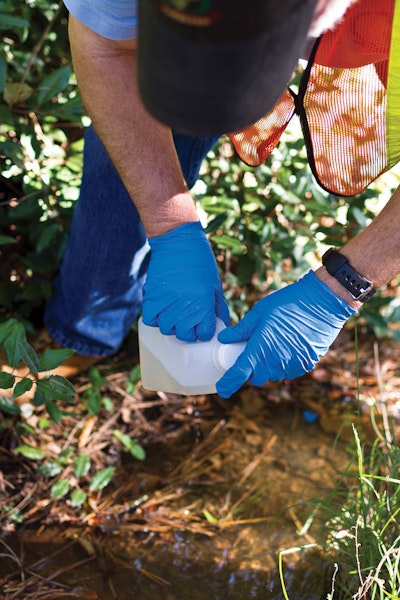Interested in Trucks?
Get Trucks articles, news and videos right in your inbox! Sign up now.
Trucks + Get AlertsHigh-powered sales strategies enabled Brant Keller, Public Works and Utilities director, in Griffin, Ga., to sell a stormwater utility to city commissioners and residents when no one appreciated the need for it.
The 23,500 city residents had lived with flooded streets and neighborhoods for so long that they accepted them as a way of life. They saw no value in a new agency that would mean another municipal fee.
Keller reverted to basic salesmanship tactics. Through storyboards and a marketing campaign, he illustrated the advantages of a stormwater utility. To brand the campaign, he hired a media relations firm to design a logo. Keller then went door-to-door and office-to-office to sell his vision and solicit support. He also petitioned U.S. EPA officials for help in persuading the Georgia Environmental Protection Division (GEPD) to support stormwater utilities.
The campaign worked so well that when the city passed the stormwater utility ordinance in 1998, only three residents attended the meeting and none objected. The utility, the first of its kind in the state, has earned numerous awards, including the 2010 Stormwater Program of the Year and the 2009 Public Education Program of the Year, both from the Georgia Association of Water Professionals.
Stormwater trilogy
The city, founded in 1843, sits on the Continental Divide, 35 miles south of Atlanta. Runoff flows south through a conveyance system built from the 1940s to the 1960s, when much of the 14-square-mile service area was agricultural. With no maintenance program, the 101 miles of pipes and more than 6,000 man-made attributes filled with sediment and debris. Water backed up and then sheet-flowed over properties.
When Keller was hired in 1992 as Public Works director, he had been a college professor, a motivational speaker, and the Public Works director of Peachtree City, Ga. He had lived in Florida for six years and was familiar with stormwater utilities. Keller also had run a $40 million window and door business in the mid-1980s. As a highly successful commission salesman, he knew he could help persuade others to accept a stormwater utility that would create a revenue stream dedicated to flood control.
According to Keller, a stormwater utility is formed from a trilogy. The first element is someone on staff who is passionate about the cause and willing to spend time researching and formulating it. That person should be a problem fixer and should have stable community relationships. The second element is elected officials to champion the cause. The third element is finding community figures who understand the value of the program and getting them involved.
Marketing and branding
As the city’s stormwater champion, Keller set about gathering facts. “Successful salespeople always present enough facts for buyers to make intelligent decisions,” he says. He went out in downpours, photographed flooded areas, and created storyboards. Public Works kept call logs for historical purposes, and Keller isolated the flooding calls to associate firsthand accounts with the photos.
With evidence in hand, Keller showed the storyboards to mayor Doug Hollberg and the assistant city administrator. When they wondered how the city would tackle the problems, Keller took them to a conference of the Florida Association of Stormwater Utilities (now the Florida Stormwater Association), where presenters explained what stormwater utilities could do. They saw the value and became champions.
“Top salesmen have key people to help develop programs, so we began looking for ours,” says Keller. The city put out a request for proposals to develop a stormwater utility and selected Hector Cyre of Water Resources Associates in Kirkland, Wash. Cyre teamed up with Ogden Environmental to engineer the capital improvements. Keller hired a media relations firm to design a stormwater utility logo and shoot a six-minute public service announcement on the benefits of stormwater utilities.
“Hector taught me to address the hard questions and never hide from the truth,” says Keller. “He said to think of a marketing campaign as if it were a debate. You must understand your opponent’s position before you can argue successfully against it.”
Best foot forward
At first, most people opposed the stormwater utility fee. Cyre and the media relations firm coached Keller until he could answer objections concisely and explain the program’s benefits to residents. He gave 120 stormwater presentations over 18 months to community groups and promoted the cause on local radio and TV programs.
When letters to the editor opposed the utility, Keller called the authors and asked to visit them. After listening to their concerns — a basic sales skill — and explaining his position, the vast majority understood why the utility was necessary.
During initial meetings with the seven city commissioners, Keller read body language to spot those with open minds. He looked for a relaxed posture with hands resting on the table, good eye contact, corners of the mouth turned upward or head nodding in agreement, and anyone taking notes or leaning toward him.
He then took receptive commissioners into the field to see the challenges and explained in detail during multiple one-on-one meetings what a stormwater utility would accomplish. “Many people in sales fail because they never ask for the order,” he says. “At the appropriate time, I would ask that individual to help me orchestrate the other officials and push this through. When he agreed, I’d close with, ‘What do I have to do to make you look good and make this happen?’ That’s how we began our relationships.”
Engaging leaders
To sway the business community, Keller looked at the top 100 firms and those with the largest impervious surfaces, then scheduled appointments with the CEO, plant manager or owner. A hospital was high on his list. Its executive director also was the committee chairman for Goals for Griffin, a city and county group. He opposed the stormwater utility and Keller needed his help to sway smaller accounts.
To establish common ground — a salesmanship rule — Keller went to the chairman’s office when streets were topping over from a heavy rain. He then used another rule of salesmanship and painted a mental picture with the director in it.
“The hospital is on the north side and our emergency medical services are four miles away on the south side,” says Keller. “One main corridor the ambulances used flooded five to eight times per year due to undersized culverts, and there are two schools on that route.”
Keller painted a verbal picture of a fully loaded school bus involved in a major accident and emergency vehicles having to detour eight miles around the flooded corridor to reach the scene. He also emphasized the potential for staff and visitors traveling to the hospital to have an accident, then asked if the director could see the relationship between flooding and the goals of a stormwater utility. He did.
After Keller asked for the sale, he closed it with, “If your ambulances can’t reach the hospital due to flooded roads, what are we accomplishing as far as Goals for Griffin?”
The director became a supporter. “Don’t say another word after asking the closing question,” Keller advises. “Any more will taint the argument.”
Point of view
Another community figure Keller needed was Nigel Thompson, general manager of a manufacturing company that was the city’s largest stormwater contributor. Keller met with him numerous times.
“I always establish trust by acknowledging the other person’s concerns,” says Keller. “I then appeal to that person’s intelligence — another basic sales rule. In this case, I explained that if he understood what we wanted to accomplish, he would be able to speak intelligently for or against it. It’s important never to argue. Selling is not the ability to win an argument. It is the ability to earn agreement.”
Keller earned Thompson’s agreement by personalizing the issue. He asked how productive employees would be if they arrived at work soaked because their vehicles had flooded. He asked Thompson to consider how his employees’ quality of life would be affected if they had an accident on a flooded street while driving to work. “If they are concerned about the stormwater fee cutting into their bottom line, redirect that concern to the cost of lost man-hours and production,” says Keller.
Funding maintenance
Before Keller could get funding for capital improvements, he also had to sell the idea of a stormwater utility to the GEPD, since that agency and the Georgia Environmental Finance Authority administered the State Revolving Loan Fund. He flew to Washington, D.C., and worked with U.S. EPA Region 4 staff to persuade GEPD to support the utility. The educational process took two-and-a-half years, but Keller received his loan.
Such collaborative efforts enabled Griffin to receive six Clean Water Act Section 319 federal grants of $3 to $4 million each for stormwater research. With dedicated revenue streams, the city was eligible for funds from the Federal Emergency Management Agency (FEMA). The city received $750,000 in FEMA money to resolve the main corridor flooding problem. It also received funds from the state Department of Transportation to mitigate pollutants on highways.
When the revolving loan fund money arrived, Keller bought a 1999 Vactor 2100 combination sewer cleaner with 12-cubic-yard debris body, 1,500-gallon freshwater tank, centrifugal compressor pulling 8,000 cfm, and 80 gpm/2,500 psi water pump. The rest of the money went toward construction.
“The day we sent out the first stormwater bill, I had a project going in each district,” Keller says. “For $2.95 per month, homeowners saw us cleaning catch basins and replacing metal hooded grates and frames to keep runoff from eroding their properties and flooding their driveways. That’s another marketing imperative: show value, show value, show value.”
Regular attention
Today, two technicians inspect and clean hot spots quarterly, second-level areas twice per year, and those least likely to overflow, once a year. They also inspect all the project detention ponds for floatables and vegetation. Depending on size, they inspect proprietary best management practices on commercial properties once or twice per year.
The team cleans the wetland mitigation ponds once cooler weather returns and snakes and insects are less active. “We also harvest invasive black willow to prevent it from forcing out the wetland plants that clean up the water,” says Keller.
Keller earned his Ph.D. in engineering management and wrote his dissertation on establishing the first stormwater utility in the state. He concluded that the nation would have 400 to 2,000 stormwater utilities by 2012.
His conclusion was accurate: Georgia alone has some 50 stormwater utilities. “Other cities followed us because we did the correct thing,” says Keller. “That’s a significant accomplishment and a benefit for our community.”









